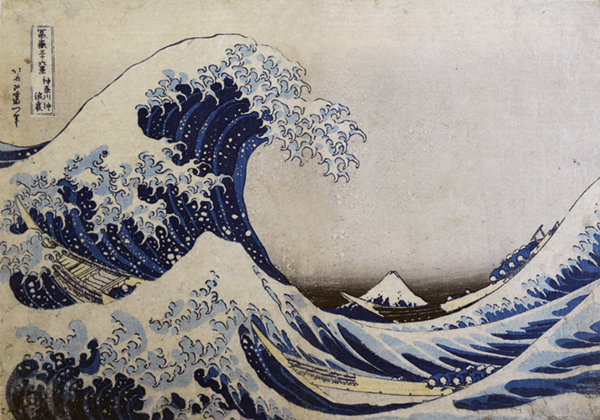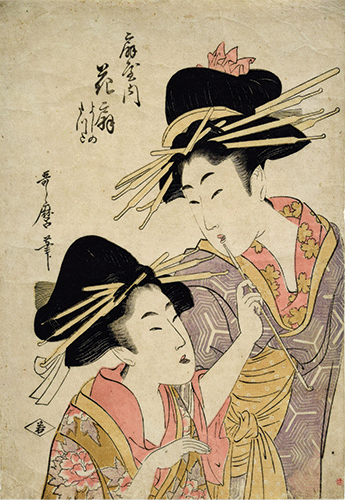 The International Museum of Art & Science (IMAS) is pleased to announce the exhibition Floating Beauty: Women in the Art of Ukiyo-e will be opening February 4, and on display through May 7.
The International Museum of Art & Science (IMAS) is pleased to announce the exhibition Floating Beauty: Women in the Art of Ukiyo-e will be opening February 4, and on display through May 7.
Floating Beauty: Women in the Art of Ukiyo-e examines the historical perspectives on the depiction of women in art during the Edo Period in Japan (1615 – 1858). This exhibition highlights female characters painted on woodblock prints, all created in the ukiyo-e style. The prints show women in literature, kabuki theatre, poetry, and courtesans as well as geishas of the Yoshiwara district. Wives and mothers from different social classes performing the duties of their station are also portrayed in the woodblocks in order to give us insight into the lives of women in pre-modern Japan. In the tradition of ukiyo-e, women are most often represented in the bijinga (“pictures of beautiful women”) genre. This was the passive, attentive, and demure idea of feminine beauties.
Looking beyond the bijinga though, the exhibition shows that women in Edo society took an active role in their own lives, and this fact is echoed through literature and drama of the period. Over fifty woodblock prints are featured in the exhibition which include works by ukiyo-e masters Kitagawa Utamaro, Suzuki Harunobu, Utagawa Kunisada, Katsushika Hokusai, Utagawa Hiroshige and Kikugawa Eizan. The entire exhibition is taken from the permanent collection of the Reading Public Museum.
Ukiyo-e, translates literally as “pictures of the floating world” and it is a Japanese art form which flourished during a period marked by drastic social, political, and economic change as the country went under military control of the Tokugawa shogunate.
 The new regime delivered peace and prosperity to the island nation and reordered social structure by dividing citizens into four classes and mobility between classes was forbidden. At the top of the system were the samurai warriors, below them were the farmers, then artisans, and finally, the merchants. The aristocratic class made up of the ruling family and his daimyos, or regional lords, lived outside of this new system. The shogun’s societal restrictions created tension and festered resentment toward the ruling class. To prevent revolts, the regime authorized the creation of Edo’s pleasure district, known as the Yoshiwara, in 1617. It was a small, walled section outside of the city. It was in this Yoshiwara that the courtesans lived and worked, where kabuki theatre was performed, and where the lower classes could show off their wealth and engage in decadent activities otherwise banned in conservative Japanese society.
The new regime delivered peace and prosperity to the island nation and reordered social structure by dividing citizens into four classes and mobility between classes was forbidden. At the top of the system were the samurai warriors, below them were the farmers, then artisans, and finally, the merchants. The aristocratic class made up of the ruling family and his daimyos, or regional lords, lived outside of this new system. The shogun’s societal restrictions created tension and festered resentment toward the ruling class. To prevent revolts, the regime authorized the creation of Edo’s pleasure district, known as the Yoshiwara, in 1617. It was a small, walled section outside of the city. It was in this Yoshiwara that the courtesans lived and worked, where kabuki theatre was performed, and where the lower classes could show off their wealth and engage in decadent activities otherwise banned in conservative Japanese society.
This new urban culture came to be known as “the floating world,” a term which described the hedonistic lifestyle of frequenting the Yoshiwara, attending kabuki plays, and patronizing brothels.
Nevertheless, the woodblock portraits reflected not only changing standards of beauty in Japanese culture but the artist’s sensibility as well as the important role that women took during those periods of time in order to see the progress of Japan in today’s society.
Floating Beauty: Women in the Art of Ukiyo-e is organized by the Reading Public Museum, Reading, Pennsylvania and supported by the Japanese Chamber of Commerce of McAllen, comprised of 16 sister companies.
The museum is located at the intersection of Bicentennial Way and Nolana Avenue at 1900 W. Nolana in McAllen, Texas. Hours of operation are 10 a.m. to 5 p.m. on Wednesdays, Thursdays, Fridays and Saturdays; 1 p.m. to 5 p.m. on Sundays. Regular admission is $5 with discounted $3 for children ages 4-12, students with an ID and senior citizens 65+. Please check the website www.theimasonline.org or call (956) 681-2800 for more information.













